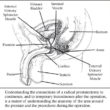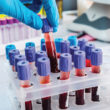Impact of continuing active surveillance after biopsy progression on the oncological outcomes after early vs. delayed radical prostatectomy
This retrospective study examined the effect of continuing active surveillance (AS) on the

oncological outcomes in 531 patients on AS for prostate cancer (grade group 1; PSA level 20
mg/mL) who were subsequently upgraded to ≥GG2, and underwent further surveillance
(biopsy, imaging, PSA testing). Patients were stratified into 3 groups in post-progression follow-
up: continue AS untreated, pursue early radical prostatectomy (RP) ≤6 months, or undergo late
RP within 6 months to 5 years of progression. Patients receiving other treatments were
excluded. This study compared characteristics between groups and examined the associations
of early vs late radical prostatectomy with risk of adverse pathology at RP and recurrence-free
survival (RFS) after RP.
Of 531 patients with biopsy progression and further surveillance, 214 (40%) remained
untreated, 192 (36%) pursued early RP and 125 (24%) underwent late RP. Among patients who
underwent early vs late RP, there was no difference in their Gleason grade group or adverse
pathology rate at RP, or 3-year recurrence-free survival after RP. In multivariable models only
cancer of prostate risk assessment post-surgical score was associated with risk of recurrence-
free survival.
Among patients continuing AS after biopsy progression, 60% underwent surgery within 5 years.
Delayed surgery after progression was not associated with higher risk of adverse pathology or
recurrence-free survival. This suggests some patients may be able to safely delay treatment
after progression. Going forward, it will be important to understand which patient qualities
(genetic, behavioral, and environmental) can allow the cautious delay of surgical intervention.
J Urol. 2022 May;207(5):1001-1009. doi: 10.1097/JU.0000000000002420. Epub 2022 Jan 4.





















